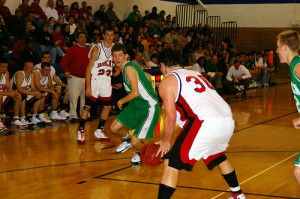How to Teach a Bounce Pass

The Bounce Pass is a very common skill used in basketball. Often though, the Bounce Pass can be poorly executed and as a result this once most used of all passes, has become discouraged by coaches. Perfecting a Bounce Pass is one thing, but also knowing when to utilise this skills can be another…
The Bounce Pass if looking to teach passing to players for the very first time is the preferred passing technique to start with. This is because it can be the slowest of all passes as well as lowering the target area for the catching position away from the face. For junior athletes this is a real advantage as when learning how to catch young children can have coordination problems initially with timing that can result in other passes, such as a Chest Pass, striking a player in the face when practicing. Using a Bounce Pass in these situations will help junior players develop confidence and coordination faster than other passing techniques.
When teaching a Bounce Pass focus on the key points below:

Start Bounce Pass from a Triple Threat Stance; in all passing situations, and just in general, when practicing different techniques have players start in a Triple Threat Stance so they become familiar with the habit
2/3rds of the Distance; a player looking to perform a Bounce Pass should aim for a spot in line with the intended receiver that is about 2/3rds of the total passing distance. This will ensure the pass still maintains speed, force and power. Any closer to being towards the middle of the distance between the two players will result in a higher bounce and rob the pass of some speed
Aim for the Belly Button; the best place for a Bounce Pass to be caught is around belly button height. Any higher and pass will be too slow. Any lower and the pass will be difficult to catch
Players start the Pass with their Feet; when performing a Bounce Pass players push through the ball. To help generate power when initially starting the pass players should step towards the intended target
Ball to Chest; when initially teaching the Bounce Pass it helps to start with the most basic technique of a two-handed pass. As a player starts to initiate their step, they should move the ball from the hip and Triple Threat Stance to the centre of the chest so both hands are equally placed on opposite sides of the ball
Elbows In; it is not unusual to see players start their Bounce Pass with their elbows raised away from the side of their bodies. This can affect passing accuracy, so the best technique is for elbows to remain at the sides of the body and the arms will then be forced to push through the ball helping with passing accuracy
Thumbs and Palms Rotate Down; as a player pushes through the pass and the arms fully extend the hands will be on the side of the ball. As maximum extension is being reached the thumbs which are pointing up will rotate to point down as the palms rotate to facing the floor. This will provide some much-needed back spin which will help the receiver in catching the ball.
Release the Pass just before Lead Foot makes Contact; stepping forward will help generate power. This power will be at its peak just before the lead foot hits the floor. Having players practicing to release the ball just before this happens ensures maximum energy is transferred to the ball
Toes, Noise and Fingers; when players push through the ball and extended their arms fully towards the intended bouncing spot. To help ensure all of the players energy is coordinated in aiming for that spot, a player’s toes, noise and fingers should be pointing in that direction
Once the basic technique is perfected the one-handed and other variations can be practiced so a range of different Bounce Passes can be employed by a player.
One particular Bounce Pass skill that should be introduced is using the technique over an extended distance so players become competent in mastering the use of bounce and speed. This is really important for older players. For some players passing in the air quickly will not be possible, however using a Bounce Pass can be more effective. This can be a problematic skill however, so will need to be practiced, especially where passing to a moving target.
The Bounce Pass is a great skill, but can be easily dismissed as an easy activity. This is often due to people feeling the technique is too simplistic and so fail to practice in the right game specific context so players become more than just able to perform the technique perfectly. Receivers as much as the passers themselves will benefit from these types of game realistic activities, as catching a high-speed Bounce Pass can be very challenging.





